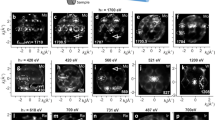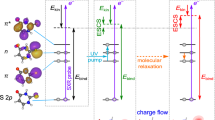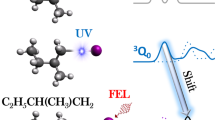Abstract
THE extensive band system of P2 in the ultraviolet is easily produced with considerable intensity by an uncondensed discharge through pure phosphorus vapour contained in a quartz tube. Regularities in the frequencies of the band heads were first found by Geuter, but the correct quantum designation of the bands has only recently been established by the work of Jakowlewa1 on the absorption and fluorescence of the more refrangible part of this system. Two years ago, Herzberg reported, in a letter to NATURE, that a sudden breaking off occurs in the band progressions associated with various upper vibrational levels (at σ′ = II with the present assignment of vibrational quantum numbers), which can only be attributed to predissociation.2 Herzberg also found that the rotational lines of the bands of highest observed ½′ stop suddenly, as was to be expected in consequence of the predissociation.
This is a preview of subscription content, access via your institution
Access options
Subscribe to this journal
Receive 51 print issues and online access
$199.00 per year
only $3.90 per issue
Buy this article
- Purchase on Springer Link
- Instant access to full article PDF
Prices may be subject to local taxes which are calculated during checkout
Similar content being viewed by others
References
Z. Physik, 69, 548; 1931.
NATURE, 126, 239, Aug. 16, 1930.
Phys. Rev., 39, 552; 1932.
Erg. exakt. Naturw., 10, 273; 1931.
Author information
Authors and Affiliations
Rights and permissions
About this article
Cite this article
JENKINS, F., ASHLEY, M. Nuclear Spin of Phosphorus from the Band Spectrum. Nature 129, 829–830 (1932). https://doi.org/10.1038/129829a0
Issue Date:
DOI: https://doi.org/10.1038/129829a0
Comments
By submitting a comment you agree to abide by our Terms and Community Guidelines. If you find something abusive or that does not comply with our terms or guidelines please flag it as inappropriate.



